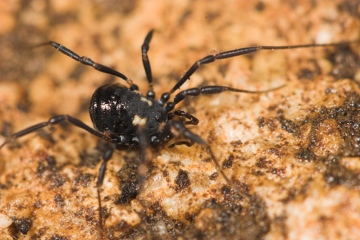Summary for Nemastoma bimaculatum (Opiliones)
previous species | next species
National Distribution
Terms of Use. Double-click on map to go to region

Explore Regional Distribution
Please log on and add a note on this species
About this species
Recorded altitude range0m to 980m
Species text
DistributionThis is the most commonly recorded British harvestman. It is a very widespread species throughout Britain, extending to most parts of the northern and western island groups. The large areas with sparse records in western Scotland, the Scottish/English border regions and mid-Wales are almost certainly under-recorded. Martens (1978) gives its European distribution as extending from Iberia through France, Belgium and western Norway. Nemastoma bimaculatum was previously confused with N. lugubre (Gruber & Martens 1968); it would be surprising if at some time in the future N. lugubre did not turn up in Britain through accidental introductions. In the Netherlands N. lugubre and N. bimaculatum are often found together (Wijnhoven 2009).
Habitat and ecology
Nemastoma bimaculatum is found from coast to mountain top (up to at least 960m in Britain) occupying microhabitats in the soil layer, below rocks, logs and other debris, and within moss and leaf-litter. It is found in both wooded and open habitats. Adults are found throughout the year and Philipson (1959) considered they live up to 18 months. They are eurychronous i.e. egg laying is not restricted to one period of the year, and generations will overlap. The juveniles are most frequent in summer and autumn. They are active on the surface at night and often caught in pitfall traps.
The palps of all stages have capitate setae i.e. hairs that are glandular and have a sticky blob on the end. These presumably act like fly paper and probably allow these harvestmen to specialise on springtails and other small, soft-bodied invertebrates suited to their small chelicerae. N. bimaculatum is not known to feed on plant material, fungi or carrion but will eat freshly dead invertebrates.
Status
A very common species.
Text based on: Hillyard, P. D. 2005. Harvestmen: keys and notes for the identification of British species. Synopses of the British Fauna 4 (3rd edn). Field Studies Council, Shrewsbury.
References
Gruber, J. & Martens, J. 1968. Morphologie, Systematik und Ökologie der Gattung Nemastoma C. L. Koch (s. str.) (Opiliones, Nemastomatidae). Senckenbergiana biologica 49: 137-172.
Martens, J. 1978. Spinnentiere, Arachnida: Weberknechte, Opiliones. Die Tierwelt Deutschlands 64: 1-464. Fischer Verlag, Jena.
Philipson, J. 1959. The seasonal occurrence, life histories and fecundity of harvest spiders (Phalangida). Entomologists’ Monthly Magazine 95: 134-138.
Wijnhoven, H. 2009. De Nederlandse hooiwagens (Opiliones) Naturalis Biodiversity Centre - Entomologische Tabellen, The Netherlands. (translation available here: http://srs.britishspiders.org.uk/portal/p/Harvestman+Resources)
References
Adult Season
Habitats
background methodology
Recorded management for locations with Nemastoma bimaculatum
Recorded substrate and hydrology for locations with Nemastoma bimaculatum
Images
please log on and upload a new image for this speciesSee also A-Z Species Index - A-Z Picture Index - previous species | next species




